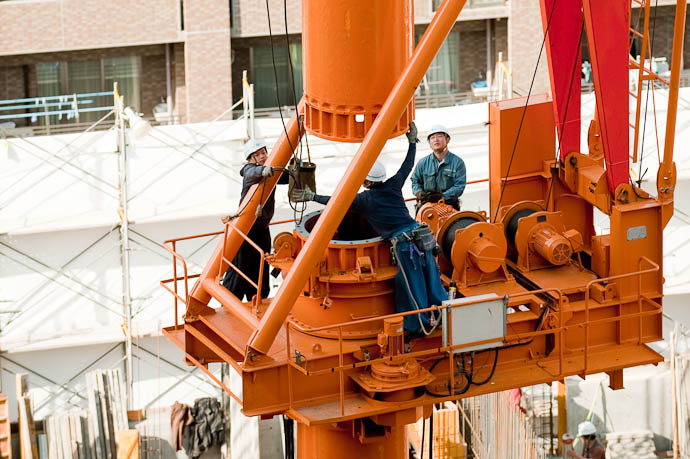
Nikon D700 + Nikkor 70-200mm f/2.8 @ 160 mm — 1/1000 sec, f/4, ISO 200 — map & image data — nearby photos
Just a Bit More...
While visiting Zak the other day at his place in Otsu, I happened to step into the hallway outside his 15th-floor apartment just in time to notice that the tower crane at the construction site next door was about to be raised a notch. Having always wondered about the details of how these cranes worked, I left Zak with three highly-energetic preschool kids (one of mine and two of his) and stepped out into the calm to watch the crane.
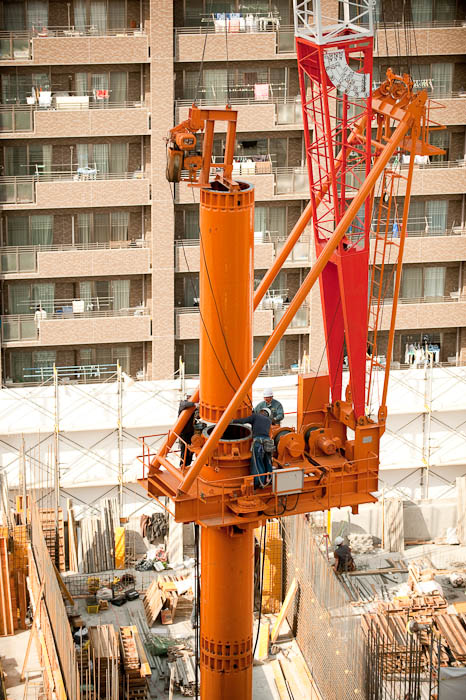
Nikon D700 + Nikkor 70-200mm f/2.8 @ 116 mm — 1/1600 sec, f/2.8, ISO 200 — map & image data — nearby photos
Lowering a New Segment Into Position
These “self-climbing tower cranes” are popular in Japan. They can be broken down and their pieces can be transported by normal trucks, and reassembled fairly quickly at the next job site. As the construction site they serve grows, they can be raised on the fly by adding new segments to their main support column.
First, they use the crane itself to lift and position the next segment of the big support column, lowering it on top of the previous segment...
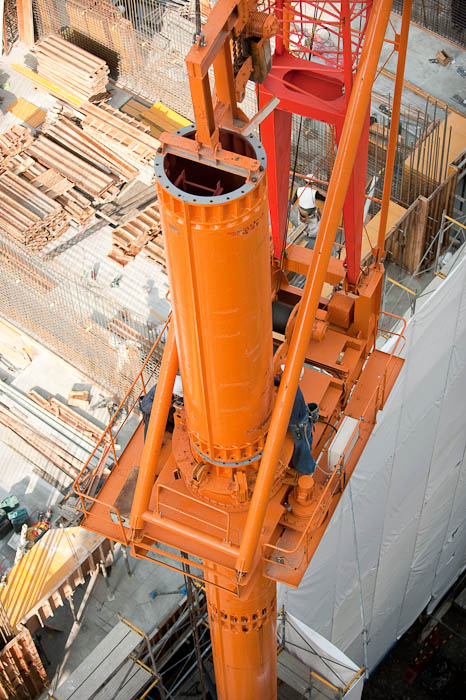
Nikon D700 + Nikkor 70-200mm f/2.8 @ 70 mm — 1/1000 sec, f/2.8, ISO 200 — map & image data — nearby photos
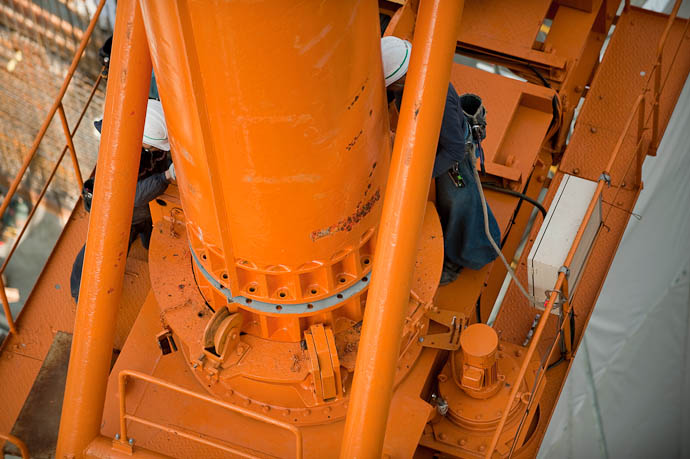
Nikon D700 + Nikkor 70-200mm f/2.8 @ 175 mm — 1/800 sec, f/2.8, ISO 200 — map & image data — nearby photos
Final Alignment
When Zak and other residents of his building bought their places, they were told that the small plot of land to the north would not be developed. Of course, they were lied to, and now a 15-story condo is going there. On the plus side, the view of the site from the top of his building is commanding, and with the crane right next to it, I had a great perch from which to watch the proceedings.
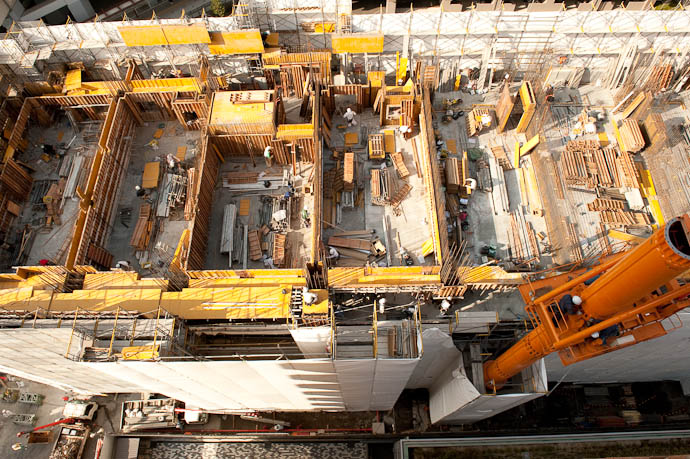
Nikon D700 + Nikkor 24-70mm f/2.8 @ 24 mm — 1/125 sec, f/14, ISO 360 — map & image data — nearby photos
Commanding View
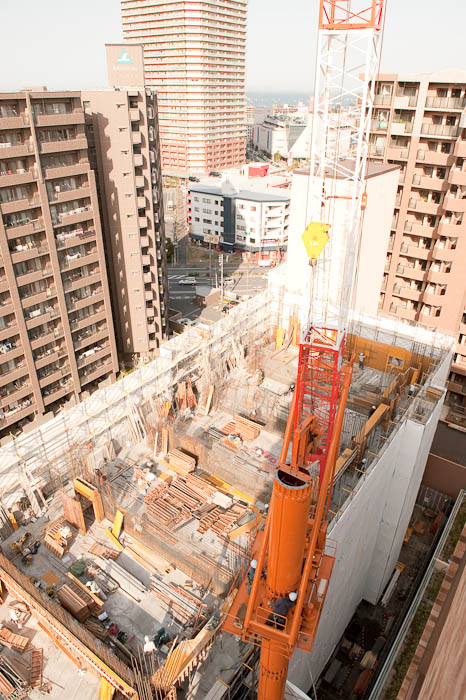
Nikon D700 + Nikkor 24-70mm f/2.8 @ 24 mm — 1/200 sec, f/9, ISO 200 — map & image data — nearby photos
Looking Northeast
the 38-story Otsu Mary is nearby
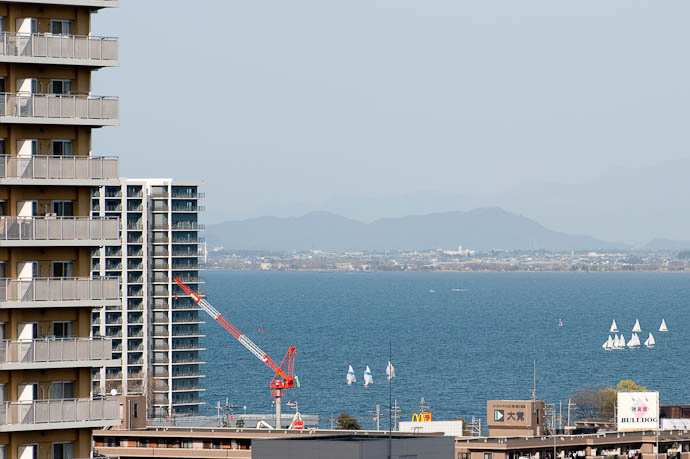
Nikon D700 + Nikkor 70-200mm f/2.8 @ 200 mm — 1/640 sec, f/8, ISO 200 — map & image data — nearby photos
Lake Biwa
beyond the Otsu Mary
In the picture above you can see a similar crane in the distance. The columns can be differing sizes, shapes, and colors, but the jibs (booms) are almost always alternating orange and white segments like the one seen above. Yesterday's “What am I?” quiz shows one corner where two segments join. The jib wasn't at the angle seen in the picture when it was right in front of me for the shot, but I tilted the camera to make it appear to be running from corner to corner.
Anyway, back to the event at hand, once the new segment was positioned, they installed 20 big bolts all around the joint, tightening each with several big whacks from a sledge hammer...
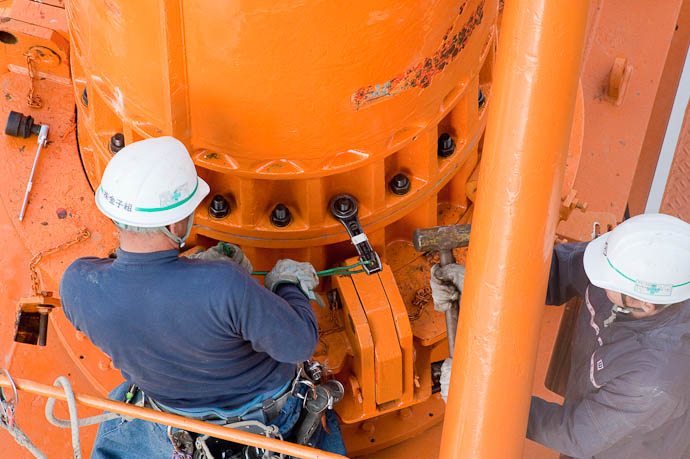
Nikon D700 + Nikkor 70-200mm f/2.8 @ 340 mm — 1/500 sec, f/13, ISO 3200 — map & image data — nearby photos
Battening Down the Hatches
so to speak
Then each nut/bolt position was marked, I suppose, so that they can notice later whether there had been any slippage....
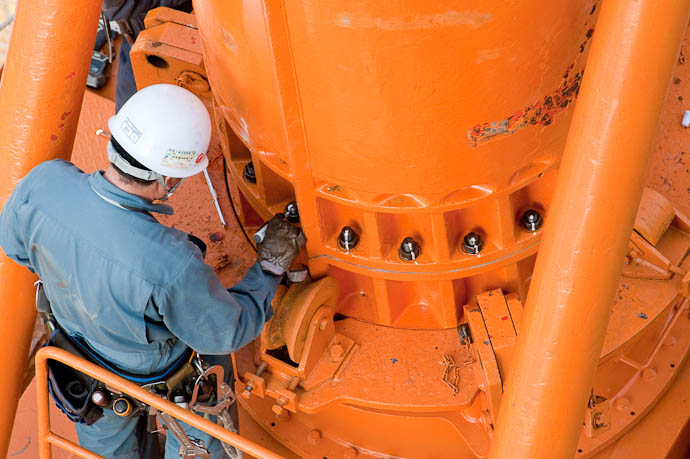
Nikon D700 + Nikkor 70-200mm f/2.8 @ 340 mm — 1/500 sec, f/13, ISO 2200 — map & image data — nearby photos
Then it was time to lift the rig up the four and a half meters (15 feet) to its new home...
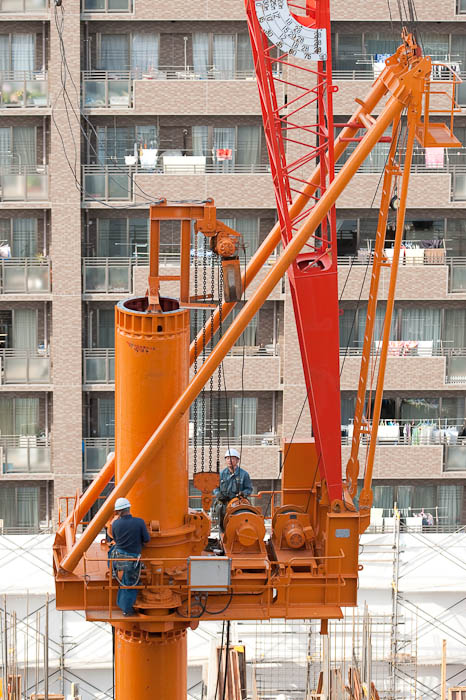
Nikon D700 + Nikkor 70-200mm f/2.8 @ 120 mm — 1/500 sec, f/7.1, ISO 640 — map & image data — nearby photos
Up She Goes
The platform is raised by the winch/chain combination in the center of the photo above. The entire weight of the platform, 98-foot jib, and three men is borne by each link in that chain. Wow.
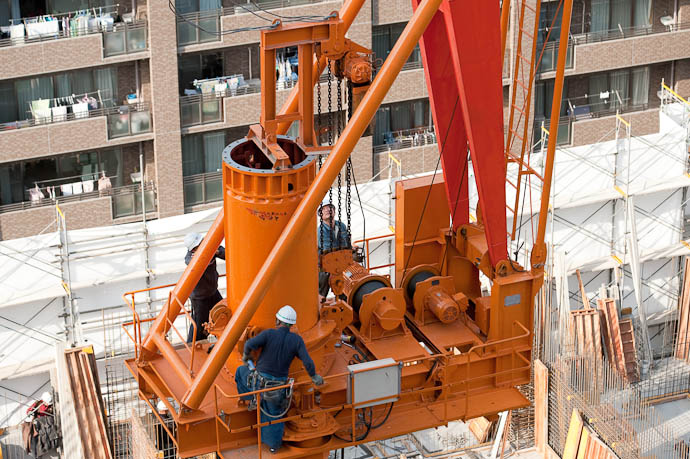
Nikon D700 + Nikkor 70-200mm f/2.8 @ 120 mm — 1/500 sec, f/7.1, ISO 400 — map & image data — nearby photos
Almost There
The entire trip took about two and a half minutes
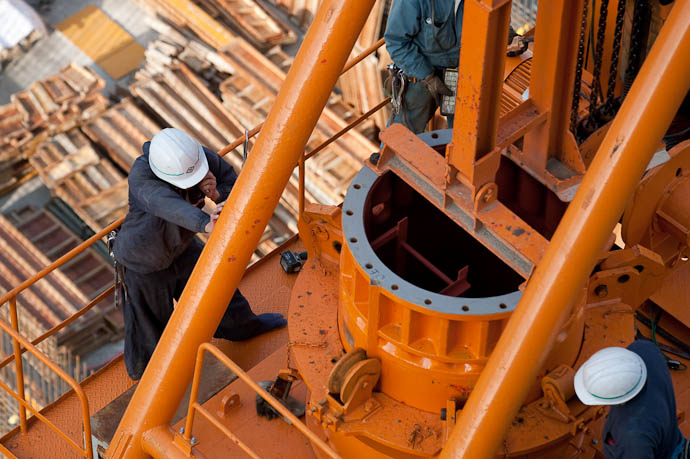
Nikon D700 + Nikkor 70-200mm f/2.8 @ 165 mm — 1/500 sec, f/4.8, ISO 250 — map & image data — nearby photos
One Foot to Go
while the guy at left chats on his cell phone
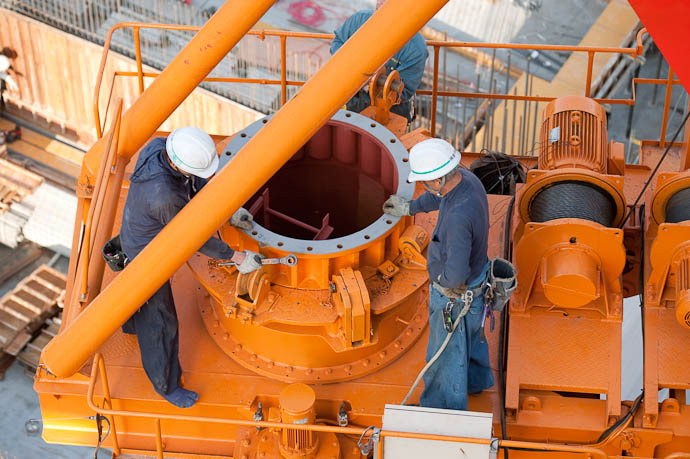
Nikon D700 + Nikkor 70-200mm f/2.8 @ 120 mm — 1/500 sec, f/4.8, ISO 360 — map & image data — nearby photos
Locking In
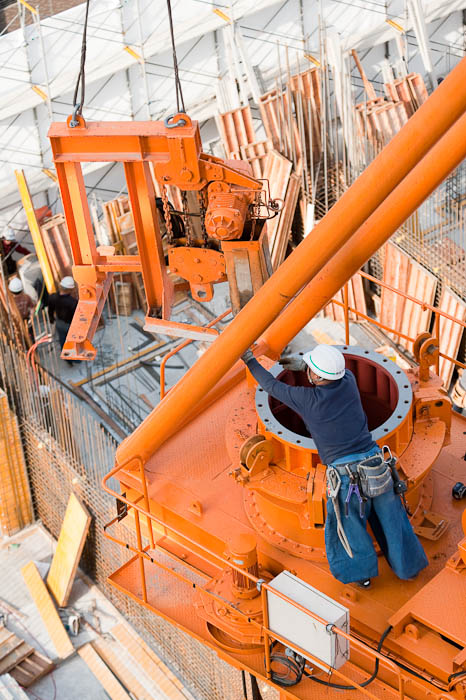
Nikon D700 + Nikkor 70-200mm f/2.8 @ 120 mm — 1/500 sec, f/5.6, ISO 400 — map & image data — nearby photos
Offloading the Winch Assembly
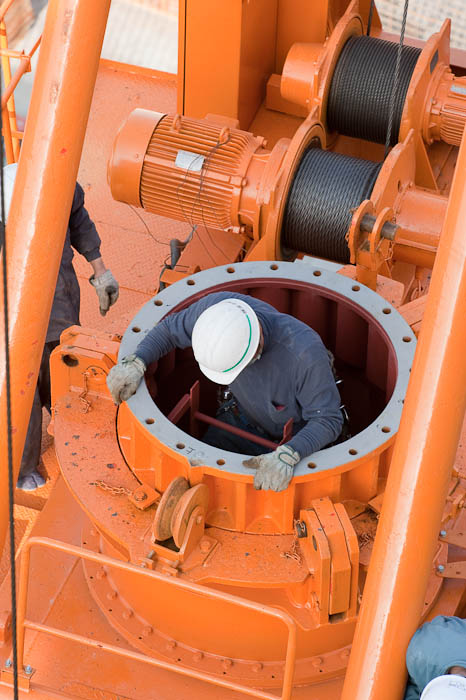
Nikon D700 + Nikkor 70-200mm f/2.8 @ 195 mm — 1/500 sec, f/8, ISO 900 — map & image data — nearby photos
Heading Back to Earth
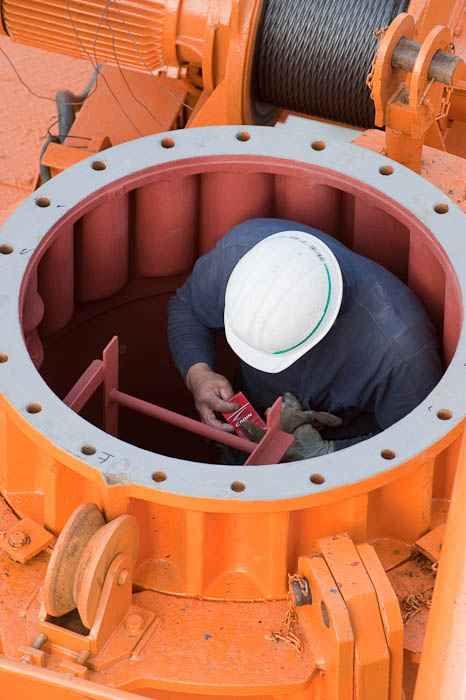
Nikon D700 + Nikkor 70-200mm f/2.8 @ 340 mm — 1/500 sec, f/8, ISO 1250 — map & image data — nearby photos
Oops, Hold On
Forgot Something Important
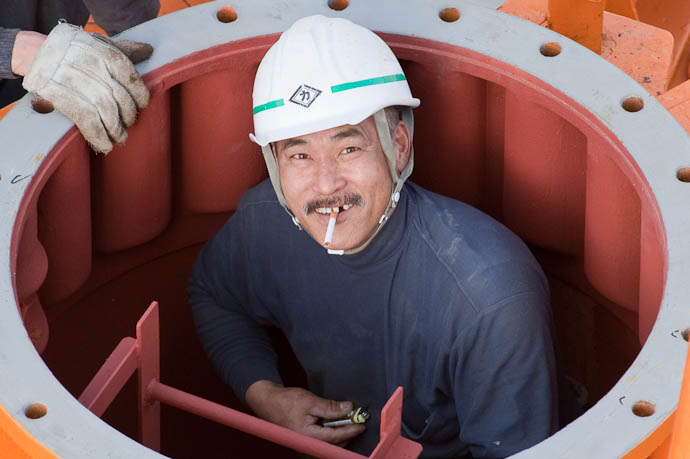
Nikon D700 + Nikkor 70-200mm f/2.8 @ 340 mm — 1/500 sec, f/8, ISO 1250 — map & image data — nearby photos
Light Me Up, Baby
The crane, built in 1991, is a Kitagawa Iron Works' JCL030II, classified as a “small climbing crane” that can reach a free-standing height of 30.8 meters (101 feet) if all seven of the 4.5-meter column segments are used, as per the schematics.
The segment they just put on looks to be the fifth, so that means they're going to climb down 74 feet in a dark, windowless tube that's not much more than three feet in diameter, smoking the whole way. Not exactly my idea of fun, but they were all smiles.
(When I first wrote this, I'd mistakenly used the specs for the next smallest crane in Kitagawa's line, the JCL015II, and none of the measurements really added up. Kudos to my brother Steve for pointing it out, allowing me to fix it so that no one else will ever know that I flubbed it up.)
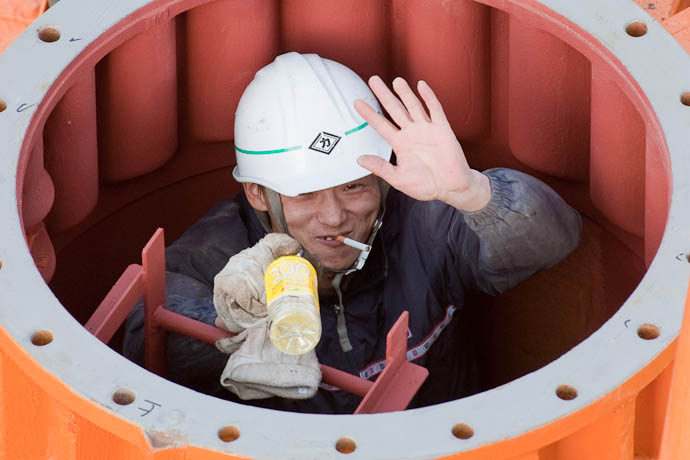
Nikon D700 + Nikkor 70-200mm f/2.8 @ 340 mm — 1/500 sec, f/8, ISO 1100 — map & image data — nearby photos
Catch Y'all Later!
You can see in the lower left of the last picture three lines written with a marker on the top face of the cylinder. That's the (upside-down from my view) character 上, which means “top”. Such a low-tech way to indicate which way the cylinder section should be installed!
Very, very interesting post! Loved the technical aspects, but was struck by two things: the VERY voluminous pants (They can’t be jeans, can they?) the workers are wearing, which would seem somewhat unsafe to me,and the fact that they wore hardhats (a good thing) but just socks, no shoes, (not a smart thing in my eyes.) Of course I may not have observed it correctly and perhaps they are wearing special footwear, but I found it curious. How did Zak manage to keep Anthony inside while this was going on?
In reverse order: Gen has lots of toys. The workers’ footware, jikatabi, are standard among construction workers. I’d like to get some if I could find size 32. The clothes are pretty standard too… and you can read all about them in Alice Gordenker’s excellent Japan Times column in Dec 2005 when she wrote about baggy trousers. —Jeffy
Hello,
What a very very interesting article ! During my 4 weeks in Japan, last year (already…:-( ) I saw much of this Crane machines. And wonder many times seing this big machine, how could they grow up.
Think this one is not as big as the one I saw in Yokohama !
Thanks for your articles, it is always a pleasure for me to read them.
Fascinating story. As always your photos are flawless. I feel as though I am in Japan once again.
Love the photo sequence. Yeah, I’ve always been fascinated by marvels of engineering and functional machines like this.
One minor nit: “The entire weight of the platform, 60-foot jib, and three men is borne, individually, by each link in that chain”
Due to the 4:1 mechanical advantage of the block and tackle arrangement, each link is only holding 1/4 of the weight.
Cheers,
~john
So if one link breaks, only 1/4 the crane falls? Or the whole crane falls only 1/4 the distance? Or, the men become only 1/4th dead?
You may be factually correct, sure, but emotionally, a whole friggin’ lot! divided by four is still “a whole friggin’ lot!” 🙂 —Jeffrey
Nice! I like these industrial shots, process sequences.
Find it interesting that you calc your cropping as focal length “Nikkor 70-200mm f/2.8 @ 340 mm.” Unless you’re using an extender, pretty sure you’d note this if so.
I was using a 1.7× extender sometimes. The “340 mm” is my way of telling you when I’m too lazy to actually write “1.7×TC”. —Jeffrey